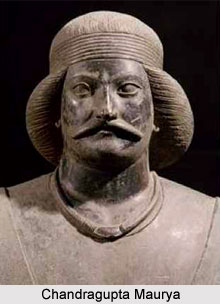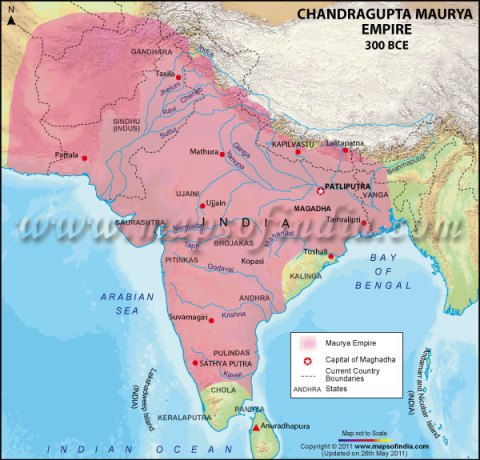
Historical Dates From Puranic Sources
Prof. Narayan Rao
http://sgm.pcriot.com/pdf/listpdf.php
Sheet Anchor Date
Professor Max Muller improved upon the work of Sir William Jones by trying to correlate the Indian history with Greek history. One ancient event the date of which is well known in the Christian era is the invasion of Alexander. However, there is no mention whatsoever of Alexander or anything connected with his invasion in any Purana or any other ancient Indian account including the Buddhist Chronicles.
Professor Max Muller then searched the Greek accounts and the narrations of the other classical European writers for the name of any Indian ruler who could be located. One such name is Sandrocottus. He is said to have succeeded Xandramese who was a contemporary of Alexander. Sir William Jones had suggested that Chandragupta of Mudra Rakshasa could be the Sandrocottus of Greek history. Professor Max Muller confirmed this identification. His main purpose was to arrive at a chronology acceptable to the intellectuals of the nineteenth century. In fact his motives and methods are best described in his own words. In his “History of Ancient
Sanskrit Literature (Allahabad Edition 1859 A.D)” Professor Max Muller writes as follows …
“There is but one means through which history of India can be connected with that of Greece, and its chronology be reduced to its proper limits. Although we look in vain in the literature of the Brahmanas or Buddhists for any allusion to Alexander’s conquest, and although it is impossible to identify any of the historical events, related by Alexander’s companions, with the historical traditions of India, one name has fortunately been preserved by classical writers who describe the events immediately following Alexander’s conquest, to form a connecting link between the history of the East and the West. This is the name of Sandrocottus or Sandrocyptus, the Sanskrit Chandragupta.
“We learn from classical writers Justin, Arrian, Diodorus Siculus, Strabo, Quintus Curtius and Plutarch, that in Alexander’s time, there was on the Ganges a powerful king of the name of Xandramese, and that soon after Alexander’s invasion, a new empire was founded there by Sandrocottus who was succeeded by Sandrocyptus. These accounts of the classical writers contain a number of distinct statements which could leave very little doubt as to the king to whom they referred.
“Indian historians, it is true, are generally so vague and so much given to exaggeration, that their kings are all very much alike, either all black or all bright. But nevertheless, if there ever was such a king of the Prasii, a usurper, residing at Pataliputra, called Sandrocottus; it is hardly possible that he should not be recognized in the historical traditions of India. The name of Chandragupta and the resemblance of this name with the name of Sandrocottus was first, I believe, pointed out by Sir William Jones. Dr.Wilford, Professor Wilson and Professor Lassen have afterwards added further evidence in confirmation of Sir William Jone’s conjecture; and although other scholars and particularly M.Troyer, in his edition of the Rajatarangini, have raised objections, we shall see that the evidence in favor of the identity of Chandragupta and Sandrocyptus is such as to admit of no reasonable doubt.”
From this identification, the coronation of Mourya Chandragupta around the year 327 B.C. was taken as the sheet anchor date for Indian chronology. Though most of the modern scholars of Indian history do not know it all the dates of ancient Indian history have been arrived at by calculating backward and forward from this sheet anchor date. For example Lord Buddha (according to some of the Buddhist chronicles) was born nearly 340 years before the coronation of Mourya Chandragupta. Accordingly his year of birth was fixed as 567 B.C.
Errors In Dating
Later as more and more Puranic and Buddhist documents were discovered those which did not confirm to the aforesaid chronology were either ignored or stated to be unreliable. For example among the different documents on Lord Buddha the Ceylonese chronicles have been accepted as most reliable though those were written much later in the Christian era in Pali language. The orientalists who have continued the research after Professor Max Muller have only tried to add to the earlier chronology without questioning its validity. Certain observations about the sheet anchor date are given in Appendix II.
Having worked out a chronology acceptable to the Europeans, the indologists started looking for archeological and other evidence to confirm it and this they thought they found in plenty in the form of stone inscriptions attributed to emperor Ashoka (and some other kings such as Kharabela). Here it must be emphasized that the European indologists deserve all the credit for their efforts to work out a detailed history of ancient India. Their failure to arrive at the correct dates and details of the events was only due to the firm belief among the intellectuals of their time that the universe is less than 6000 years old. Unfortunately, in the process they have altered certain verses and otherwise mutilated the texts of the Puranas in their editions, such as Wilson’s Vishnu Purana, which are today most widely read.
The Christian missionaries have also been unintentionally guilty of such vandalism as they have often destroyed some of the manuscripts of Puranas which fell in their hands. They were doing so with the firm belief that by such destruction they are saving the posterity from these sin provoking documents. However, sufficient number of the different versions of the different Puranas is still available in the monasteries in India, as well as the libraries in Great Britain, Germany, America and other countries for a complete and correct chronology of Indian history to be worked out.
In calculating the dates from the Puranas the following procedure should be adopted to rectify the errors and discrepancies.
1. Proper distinction should be made between the Puranas and the other ancient texts. For example, Abhigyana Shakuntalam, Mudra Rakshasa, Raghu Vansa, Harsha Charita etc. are magnificent literary works and not historical documents.
2. In some Puranas the dates are given in more than one era. In such cases comparison should be made to detect any possible error. Possible grammatical errors as well as the consistency and continuity of the verses should be carefully checked.
3 The dates of events worked out from different Puranas should be tallied and compared with the dates worked out from astronomical data.






